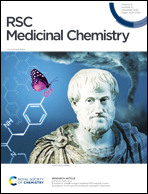Current status of Fe-based MOFs in biomedical applications
Abstract
Recently nanoparticle-based platforms have gained interest as drug delivery systems and diagnostic agents, especially in cancer therapy. With their ability to provide preferential accumulation at target sites, nanocarrier-constructed antitumor drugs can improve therapeutic efficiency and bioavailability. In contrast, metal–organic frameworks (MOFs) have received increasing academic interest as an outstanding class of coordination polymers that combine porous structures with high drug loading via temperature modulation and ligand interactions, overcoming the drawbacks of conventional drug carriers. FeIII-based MOFs are one of many with high biocompatibility and good drug loading capacity, as well as unique Fenton reactivity and superparamagnetism, making them highly promising in chemodynamic and photothermal therapy, and magnetic resonance imaging. Given this, this article summarizes the applications of FeIII-based MOFs in three significant fields: chemodynamic therapy, photothermal therapy and MRI, suggesting a logical route to new strategies. This article concludes by summarising the primary challenges and development prospects in these promising research areas.



 Please wait while we load your content...
Please wait while we load your content...